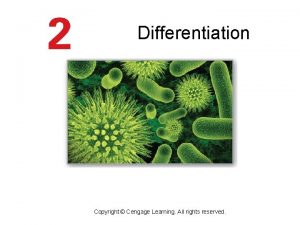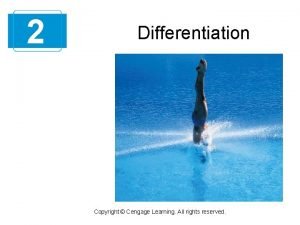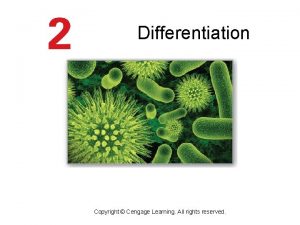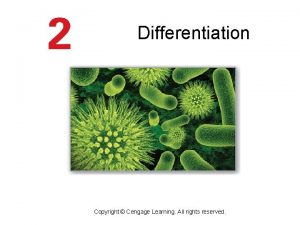Implicit Differentiation Copyright Cengage Learning All rights reserved














- Slides: 14

Implicit Differentiation Copyright © Cengage Learning. All rights reserved.

Objectives n Distinguish between functions written in implicit form and explicit form. n Use implicit differentiation to find the derivative of a function. 2

Implicit and Explicit Functions Most functions have been expressed in explicit form. For example, in the equation explicitly written as a function of x. , the variable y is Some functions, however, are only implied by an equation. For instance, the function y = 1/x is defined implicitly by the equation xy= 1 Implicit form 3

Implicit and Explicit Functions To find dy/dx for this equation, you can write y explicitly as a function of x and then differentiate. This strategy works whenever you can solve for the function explicitly. You cannot, however, use this procedure when you are unable to solve for y as a function of x. 4

Implicit and Explicit Functions For instance, how would you find dy/dx for the equation For this equation, it is difficult to express y as a function of x explicitly. To do this, you can use implicit differentiation. 5

Implicit and Explicit Functions To understand how to find dy/dx implicitly, you must realize that the differentiation is taking place with respect to x. This means that when you differentiate terms involving x alone, you can differentiate as usual. However, when you differentiate terms involving y, you must apply the Chain Rule, because you are assuming that y is defined implicitly as a differentiable function of x. 6

Example 1 – Differentiating with Respect to x 7

Example 1 – Differentiating with Respect to x cont’d 8

Implicit Differentiation 9

Example 2 – Implicit Differentiation Find dy/dx given that y 3 + y 2 – 5 y – x 2 = – 4. Solution: 10

Implicit Differentiation To see how you can use an implicit derivative, consider the graph shown in Figure 2. 27. From the graph, you can see that y is not a function of x. Even so, the derivative found in Example 2 gives a formula for the slope of the tangent line at a point on this graph. The slopes at several points on the graph are shown below the graph. Figure 2. 27 11

Implicit Differentiation It is meaningless to solve for dy/dx in an equation that has no solution points. (For example, x 2 + y 2 = - 4 had no solution points. ) If, however, a segment of a graph can be represented by a differentiable equation, then dy/dx will have meaning as the slope at each point of the segment. Recall that a function is not differentiable at (a) points with vertical tangents and (b) points at which the function is not continuous. 12

Example 5 – Finding the Slope of a Graph Implicitly Determine the slope of the graph of 3(x 2 + y 2)2 = 100 xy at the point (3, 1). Solution: 13

Example 5 – Solution cont’d At the point (3, 1), the slope of the graph is as shown in Figure 2. 30. This graph is called a lemniscate. Figure 2. 30 14
 Copyright 2015 all rights reserved
Copyright 2015 all rights reserved Copyright 2015 all rights reserved
Copyright 2015 all rights reserved Dell all rights reserved copyright 2009
Dell all rights reserved copyright 2009 Copyright © 2018 all rights reserved
Copyright © 2018 all rights reserved Cengage chapter 7
Cengage chapter 7 Specification by example
Specification by example All rights reserved sentence
All rights reserved sentence Freesound content licence
Freesound content licence Confidential all rights reserved
Confidential all rights reserved Sentinel controlled repetition
Sentinel controlled repetition 2012 pearson education inc
2012 pearson education inc Microsoft corporation. all rights reserved.
Microsoft corporation. all rights reserved. Microsoft corporation. all rights reserved.
Microsoft corporation. all rights reserved. Microsoft corporation. all rights reserved.
Microsoft corporation. all rights reserved. Pearson education inc. all rights reserved
Pearson education inc. all rights reserved



























